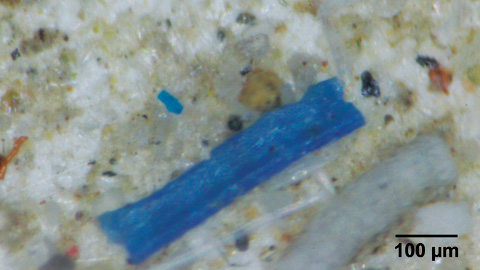The Ebro River annually dumps 2.2 billion microplastics into the sea

04/07/2019
Rivers are considered the main pathway for microplastic pollution to reach oceans. A relevant portion of these pollutants accumulates on the beaches and in the estuarine sediments. This is clear from a research developed by the Institute of Environmental Science and Technology of the Universitat Autònoma de Barcelona that analyses microplastic concentrations in the Ebro River Delta in order to quantify and understand the distribution of these pollutants in aquatic systems. The authors claim that there is need for further research on the hazards that the accumulation of these pollutants in fishing and aquaculture areas may have for human health.
Microplastic pollution is considered one of the main environmental problems threatening our ecosystems, mainly our aquatic ecosystems. Microplastics are particles or fibers smaller than 5 mm. They can be “primary” microplastics such as raw material used to create plastic products (pellets), small particles used for cosmetic purposes, beads for industrial abrasive blasting media or fibers for textile purposes, or “secondary” microplastics, originated from the degradations of larger plastic items.
Until now, the studies on microplastic pollution have focused on its presence in oceans and seas, and little consideration has been given to the rivers as one of the main sources of these pollutants, says Patrizia Ziveri, coordinator of the research group. The study, carried out by ICTA-UAB researchers and recently published in the journal Science of the Total Environment, analyses for the first time the accumulation of microplastics in the Ebro River Delta in different areas: in sandy beaches on the northern edge of the delta, in surface waters and in estuarine benthic sediments.
The results show that rivers are one of the main sources of microplastics entering the oceans. In particular, they estimate that surface waters annually discharge 2.2 billion microplastics into the Mediterranean Sea. “Microplastic pollution in the Ebro Estuary could be considered intermediate-low compared to the values reported in other estuaries, but it must be taken into account that the flow of the Ebro River is tightly regulated by the dams of Mequinenza and Ribaroja. These dams could be acting as a first filter reducing the amount of microplastics that reach the estuarine”, explains ICTA-UAB researcher Laura Simón. They believe that higher abundance of microplastics could be expected in rivers located closer to urban areas under high anthropogenic pressure.
In the study, the values found in benthic sediments are three to six time higher than on sandy beaches of the estuarine. “This concentration is due to the influence of the salt wedge - spacing between fresh water and ocean water - where the flow velocity is lower and the retention time is longer”, adds ICTA-UAB researcher Michaël Grelaud.
Overall, 70% of the microplastics found in the Ebro River Delta are synthetic fibers, followed by plastic fragments and films. The amount of fibers dumped into the Mediterranean Sea annually is equivalent to 600 kilometres. “Most of these fibers arrive to the river through wastewater effluents and treatment plants as consequence of domestic and commercial laundry. Up to 2000 fibers can be released washing a single garment of clothing. Wastewater treatment plants are not able to remove all the textile fibers”, says Simón.
Researchers highlight the great potentiality of the deltas and estuaries to accumulate microplastics, which are accumulators of toxics. According to Jordi Garcia-Orellana, transitional areas between freshwater and marine water make these open ecosystems critical zones to calculate the fluxes of microplastics that reach marine systems using the rivers as direct corridors. Researchers consider that more studies are needed on the residence times of microplastics in the different environmental areas to therefore assess the level of hazard of these pollutants to aquatic organisms and, by extension, to human health.
Scientific article
Simon-Sánchez L., Grelaud M., Garcia-Orellana J., Ziveri P. (2019). River Deltas as hotspots of microplastic accumulation: The case study of the Ebro River (NW Mediterranean). Science of the Total Environment. https://doi.org/10.1016/j.scitotenv.2019.06.168